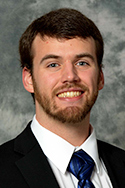General Surgeons: Lifesaving and Routine Care In Rural Communities
by Casey Ricker
December 2020
Picture this: A mid-winter snow is falling outside during a Sunday family supper. While relaxing after the meal, the belly pain starts, right side. Thinking it will go away like the last three times, it doesn't. Monday morning, it's still there, now with a fever. After calling the clinic, getting worked into a provider's schedule, and getting an ultrasound, the diagnosis is given: acute cholecystitis, an angry, infected, and inflamed gallbladder. Now a general surgeon is needed.
“About 1 in 10 North Dakotans have gallstones, along with as many as 20 million other Americans.”
The gallbladder is small pouch beneath the liver that stores bile that helps digest fats. Sometimes stones develop from the fluid and when the gallbladder squeezes the fluid out, the stones plug the pipe, causing pain and sometimes causes the cholecystitis. About 1 in 10 North Dakotans have gallstones, along with as many as 20 million other Americans. For most people, the stones will never become a problem. However, when they do, they can cause life-threatening illness and a surgeon is needed quick. Despite its seriousness, it sometimes can be managed as a same day surgery and the patient can return home several hours after surgery.
Along with unhappy gallbladders, a list of common surgical problems include bad appendixes, breast and colon cancer, life-threatening obstructed bowels, and other conditions that require the expertise of a general surgeon. General surgeons, important members of the local healthcare team, are like the Swiss Army knife of physicians trained in surgical procedures. A general surgeon has broad knowledge about both medical and surgical conditions, in addition to possessing a wide array of surgical skills. Because in rural North Dakota accidents are being caused by cattle that remain unpredictable, farm equipment that is only getting larger, and road accidents that increase as the number of rural miles driven every year increases, a nearby general surgeon who's able to treat these traumatic injuries reduces the time to treatment, an interval that always factors into survival and best outcomes. General surgeons can also perform C-sections, a procedure that saves mother and baby.
Having a surgeon in the local community helps provide other specialized care: procedures like removing skin lesions suspicious for cancer, draining abscesses, colonoscopies, and other “scope” procedures. Their work doesn't end when the surgery does. They still follow patients in the hospital after surgery and follow up with patients in the clinic to make sure they're healing well. Sometimes the local surgeon can even do post-op checks on patients who had very specialized surgery done elsewhere so the patient doesn't have to travel for things that have healed enough for a general surgeon to oversee the remaining healing.
Across the country there is a shortage of general surgeons. Rural areas in particular are keenly feeling this deficit. This need is addressed by programs that have a special focus on training general surgeons for the rigors of rural practice. Currently, only 11 of the approximately 258 general surgery residencies in the United States have these rural training tracks. The University of North Dakota is one of them. Graduating five qualified surgeons each year, over 25% of the program's graduates are practicing in North Dakota.
Though not all rural North Dakota communities are able to have a general surgeon as a member of their rural healthcare team, when they are present they are an invaluable asset to their communities. They bring with them many services that can prevent several hours of transport to another locations of care. Having those surgical skills local allows patients to stay close to family and friends, because general surgeons also understand there's no place like home.
This article also appeared in the December 17, 2020 issue of the Adams County Record.
About the Author
 Casey Ricker is a third-year medical student at
the University of North Dakota School of Medicine &
Health Sciences. He was selected as the Hettinger
participant for the school's ROME program, or Rural
Opportunities in Medical Education. Because the program
includes teaching student doctors about the importance of
how rural newspapers can deliver health information, he
has written this column for his ROME community. The
information is not for diagnosis or treatment and should
not be used in place of previous medical advice provided
by a licensed practitioner.
Casey Ricker is a third-year medical student at
the University of North Dakota School of Medicine &
Health Sciences. He was selected as the Hettinger
participant for the school's ROME program, or Rural
Opportunities in Medical Education. Because the program
includes teaching student doctors about the importance of
how rural newspapers can deliver health information, he
has written this column for his ROME community. The
information is not for diagnosis or treatment and should
not be used in place of previous medical advice provided
by a licensed practitioner.
